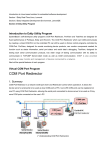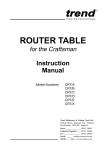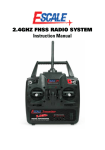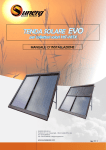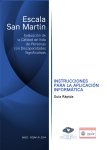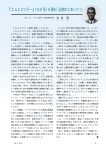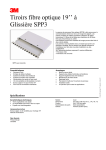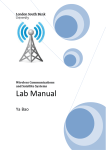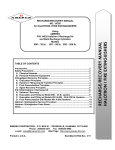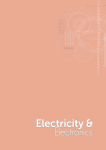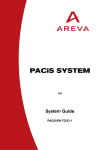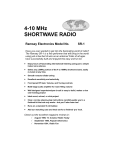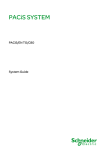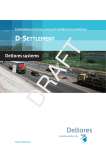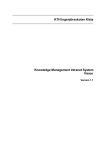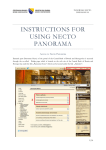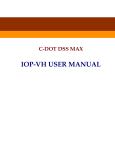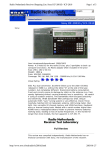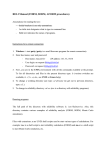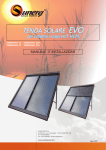Download Telecommunications Range Brochure
Transcript
Telecommunications Telecommunications Telecommunications Workstation Antenna Lab Transmission Lines Microwave Prinicples Microstrip Technology Fibre Optics Wireless Communications LAN Trainer Network & Data Security AM & FM Radio Espial Courseware Telecommunications is one of the world’s fastest growing industries and world-wide personal communication of voice, picture and data is now commonplace. The Feedback range of Telecommunications training equipment has been designed to provide a modern, efficient approach to training the engineers and technicians working in this field. Feedback’s philosophy is to equip students with the fundamental ideas and principles that underpin modern telecommunications practice by using versatile trainers that quickly and clearly demonstrate the required characteristics. Paramount to all Feedback equipment is the principle that students of engineering and technology should work with hardware and be allowed to take a hands-on approach. All of Feedback’s teaching hardware is supported by extensive teaching and theoretical courseware. This can either be in the form of paper manuals or software. Within the Telecommunications range, Feedback offers hardware that can be used in conjunction with conventional test and measurement equipment, using paper manuals. Alternatively, laboratory work can be carried out using equipment connected to a PC enabling it to take advantage of Feedback’s Espial courseware, which offers on-screen instruction and embedded, real-time, virtual instrumentation. Both these teaching philosophies are valid ways of demonstrating technical characteristics, but the underlying principle that both share is giving the student the opportunity to work with real hardware and avoid simulation. Features • Ideally suited for University and Technical College courses • Covers analogue and digital telecommunications • All products provided with in-depth teaching manuals or software • Compact, bench-top systems • Teaching material relevant to industrial practice Telecommunications - 32 - mmunications Workstation 53-004 nician aching nts lation e nd ESPIAL The Telecommunications Workstation range of products consist of a series of open-board trainers that work in conjunction with Discovery software. S oft wa re The 53-004 comprises three workboards: Amplifiers and Oscillators 53-210, Tuned Circuits and Filters 53-220 and Modulation and Coding 53-230 and the 92-200 USB Real-time Access Terminal (RAT). The close integration of the hardware workboard with computer-based instruction and instrumentation software provides the student with a rich learning environment and the tutor with a cost-effective solution in this field of telecommunications teaching. d, theory ons bedded ding a ents of operties yzer red on or th Integrated instructions and Instrumentation Integrated instructions and instrumentation Further in-depth information always available Further in-depth information always available Each practical experiment is configured by patching together circuit blocks on the boards. The patching sequence is shown sequentially through the software. The workboard connects to a personal computer via the USB Real-time Espial Software is Feedback’s Espial is written in such a way that its The interactivity of Access Terminal (92-200 RAT), which is a fast Analogue-to-Digital converter, continuously evolving software package. appearance and the instrumentation Espial means that it sampling signals on the workboard at rates from 10 to 100MHz, as required. The basic and most important made available depends on the provides real-time, PC The Terminal also provides all the necessary power supplies for the workboard. philosophy of Espial is its interactivity practical being executed. So, if the based instrumentation with teaching hardware. Espial can practical requires the display of a and in the case of be applied to products within our constellation or a phase meter, as Telecommunications this complete range of teaching products in QAM experiments, one is made includes: and is used extensively within the available whereas at lower levels Telecommunications range. of study it would not be provided. • Dual channel Espial software can be installed either Oscilloscope The learning material is provided in a stand-alone configuration or • Spectrum Analyzer within the software and this includes networked and centrally served. • Voltmeter the underlying theory, which is written • Frequency Counter in such a way that it does not use • Phasor and mathematics at too high a level. Constellation Displays An important part of the teaching • Bit Error Rate (BER) programme is to highlight the learning Meter objectives of the various experiments • Antenna Polar and convey the background involved Diagram Plotter to the student: This information is also included in the software. Consequently, the student is suitably prepared to start the practical work using the hardware. ers and Oscillators Workboard 53-210 ge r ier buffering r This workboard allows the construction of various Amplifiers, Oscillators and Signal Sources. The workboard shows the principles of R-C, L-C and crystal oscillators, feedback, loop gain, amplitude stabilisation, oscillation, distortion and frequency stability. Using the PC instrumentation, Nyquist and Bode diagrams can be easily shown. Telecommunications - 33 - 57-200 AntennaLab Features • Feedback Espial teaching software • Unique integration of hardware and software • Models and tests real antennas • Hardware modelling ‘between 1200 MHz and 1800 MHz • PC based measurement and results • Rapid, graphic display of antenna characteristics • Bench-top operation • Low, safe power output • USB interface The AntennaLab is a unique system designed to be used in two distinct ways: for teaching and demonstrating common antenna configurations at all levels of study, and as a design tool by those engaged in research and development. The equipment comprises two towers, one being a low power transmitter, controlled by a frequency synthesizer. The second contains a frequency synthesiser controlled receiver. The antenna to be investigated is mounted on top of the transmitter tower. The transmitter tower can be rotated through 360 degrees and displays the following characteristics: • Signal level • Frequency response • Polar diagrams • Return loss plots • E & H planes in three dimensions • Bandwidth Telecommunications - 34 - Subject Areas • • • • • • • • • • • • • • • The Dipole in free space Effects of the surroundings Dual sources Gain, directivity and aperture Ground reflections The monopole Phased monopoles Resonance, impedance and standing waves Return loss and VSWR measurements Parasitic elements Multi-element parasitic arrays Stacked and bayed arrays The log periodic antenna The horn antenna The dish antenna TLD511 Transmission Line Demonstrator TLD511 Transmission Line Demonstrator TLD511 Transmission Line Demonstrator This system demonstrates the characteristics of transmission lines in a graphic manner. The system uses a simulated line that effectively displays the high frequency characteristics of a transmission line at low frequencies so that they can be easily observed. The line characteristics can be easily adjusted by the operator. The line is completely symmetrical so that either end may be regarded as an input or an output. The unit features large, bright LEDs, a builtin step function generator and is supplied with a manual. Subject Areas Features • • • • • • • • • • • • • • • • • Propagation of a wave front Propagation of a sinewave Effect of wavelength Attenuation and dispersion Terminations Reflection, standing waves and characteristic impedance Partial reflection, standing waves and superposition of incident and reflected waves Resonance and the effect of attenuation 1 to 1 impedance transformations Lines with dissimilar lossless terminations Resonance and capacitive detuning Reactive line impedance either side of resonance Large bright LED display Built-in step function process Variable simulated line length Manual hold facility Comprehensive manual Variable Phase Generator VPG608 Recommended accessory: • • • • • Frequency range 0.01 Hz to 1 kHz Phase shift from -180° to +180° Outputs variable up to 10 V pk - pk Attenuation of x 1 x 0.1 and x 0.01 Square & triangular auxiliary outputs • VCF and SYNC facility ASD512 - Antenna System Demonstrator ASD512 Antenna Demonstrator This is a fully operational antenna system that has been designed to provide an ideal classroom demonstrator. The system uses a kit of parts to allow many types of antenna to be constructed, making the system versatile as a demonstrator of both antenna principles and practice. Two hand-held detectors are provided that show relative magnitudes of voltage and current fields around the antenna, and the field strength of the antenna. The system works at a frequency of 167.2 MHz, giving a half-wave element of approximately 90 cm. Features Subject Areas • • • • • • • • • • • • Basic theory of radiation Radiating and non-radiating systems Feeders Radiation resistance Drive point impedance and ground resistance Physical and electrical length Directional antennas and radiation patterns Parasitic arrays & antenna gain Antenna with folded elements Slot radiators 3-dimensional polar diagrams Loop antenna • Fully operational antennas • Displays of antenna characteristics • Convenient size for classroom • Versatile and easy to assemble • Complex concepts made easy • Reconciles theory and practice Telecommunications - 35 - AM2961/FM2962 Radio Systems Trainer AM2961 Radio Systems Trainer FM2962 FM Stereo Radio Systems Trainer Features AM2961 • Covers the principles of AM radio signal generation and reception • Single and Double sideband with suppressed carrier • Receiver operating at 500 - 1600 kHz (MW) & 3 - 4 MHz (SW) • One fixed generator frequency in each band • Switched faults on both boards Features FM2962 • Covers the principles of FM radio signal generation and reception • Stereo transmission and reception • Extensive use of monitoring points for signal tracing • Switched faults on both boards AM Radio Systems Trainer AM2961 The AM Radio Systems Trainer comprises two open-boards: AM2961A, AM/DSB/ SSB generator AM2961B, AM/DSB/SSB receiver. The AM circuits operate within the AM broadcast band and the DSB/ SSB circuits operate within the 80 m ‘ham band’. The generator output is only a few milliwatts, so the range of transmission is extremely limited. The receiver has an integral antenna, but may also be used, with the addition of an external antenna, to receive normal broadcast and amateur signals. The principles and techniques of AM with full carrier, double-sideband and singlesideband suppressed carrier transmission and reception can be easily investigated. Subject Areas - AM2961 • • • • • • • Modulation and demodulation Mixing techniques Filtering RF and audio AGC RF, IF and AF amplification LC, crystal and VCO oscillators Single and double sideband Telecommunications - 36 - FM Stereo Radio Systems Trainer FM2962 - The FM Stereo Radio Systems Trainer comprises two open-boards: FM2962A, stereo generator & FM2962B, stereo receiver. The FM receiver circuits operate over a range of 88-108 MHz and the generator provides a fixed output frequency of 100 MHz with a 19 kHz pilot tone. The generator output is only a few miliwatts, so the range of transmission is extremely limited. The receiver operates on an IF frequency of 10.7 MHz in stereo or mono mode and may also be used with an external antenna to receive normal broadcast and amateur signals. Switched faults can be introduced on both generator and receiver units. Fault options include Multiplex, Pilot tone and Mute errors; power for tuner, audio and demodulator, forces tuning volts to zero and high-gain AFC loops locking to a signal. Subject Areas - FM2962 • Familiarisation with FM multiplex stereo transmission and reception • Frequency modulation • Stereo multiplex encoding, pre-emphasis, pilot tones and sub-carriers • FM reception, filtering, limiting and AFC • FM demodulation • Stereo multiplex decoding, de-emphasis and audio amplification 53-004 Telecoms Workstation 53-004 Telecommunications Workstation. The system comprises: Amplifiers and Oscillators 53-210, Tuned Circuits and Filters 53-220 and Modulation and Coding 53-230 and PC interface. Teaching content and instrumentation is provided using Espial software. 53-210 Amplifiers & Oscillators Workboard 53-210 Amplifiers and Oscillators Workboard. This workboard allows the construction of various Amplifiers, Oscillators and Signal Sources. The workboard shows the principles of R-C, L-C and crystal oscillators, feedback, loop gain, amplitude stabilisation, oscillation, distortion and frequency stability. Using the PC instrumentation, Nyquist and Bode diagrams can be easily shown. 53-220 Tuned Circuit and Filters Workboard. With these circuits, students can examine the principles of passive filters, R-C and L-C tuned circuits, Q loading, low-pass crystal filters, active filters, tuned amplifiers and automatic gain control (AGC). 53-220 Tuned Circuits & Filters Workboard 53-230 Modulation and Coding Workboard. Is a fully-featured, complete, laboratory course covering the principles of operation and the practical implementation of modern modulation systems required for both analogue and digital communication systems. Subject Areas- 53-210 • Voltage, Current input and Controlled gain amplifier • Oscillation criteria • Wien bridge oscillator • Tuned amplifier • LC & Crystal oscillator • Oscillator stability & buffering • Multivibrator • Tuned power amplifiers Subject Areas - 53-220 • Crystal filters • Tuned & coupled tuned circuits • Ceramic bandpass & LC high pass filters • Audio op-amp & LC low pass filters • Butterworth, Chebyshev & High-order filters Subject Areas- 53-230 • Signals in the time and frequency domains • Sampling and Time Division Multiplexing (TDM) • Amplitude Modulation (AM) & AM with Suppressed Carrier • SSB generation with an IQ modulator • Amplitude Shift Keying (ASK) • Frequency Modulation (FM) & FM with an IQ modulator • Frequency Shift Keying (FSK) • Phase Modulation (PM) • Phase Shift Keying (PSK) • Multi-state Phase Shift Keying • Quadrature Amplitude Modulation (QAM) • Uncoded binary data formats • Bi-phase data format • Alternate mark inversion 53-230 Modulation & Coding Workboard Telecommunications - 37 - 56-200 M i crowa v e Tr a in e r 56-200 Microwave Trainer Features - 56-200 • Stand-alone, low cost system • No ancillary equipment required • Simple, robust stands for antennas • Modulated 10.425 GHz solid-state DRO source • Components identified with inscribed reference number Microwave Trainer 56-200 - This instrument allows the user to investigate the principles of microwave transmission systems, such as those used in radar and communications. It uses standard type WG16 (WR90) wave-guide components to illustrate the essential elements. It is completely self-contained and allows students to carry-out realistic practical work. The equipment has a modulated dielectric resonance oscil ator (DRO), X-band source, a selection of waveguide components, a console containing a power supply, a demodulation circuit and a meter that monitors the detector output. Subject Areas - 56-200 • Introduction to microwave waveguide bench and measurement of source frequency and guide wavelength. • Voltage Standing Wave Ratio (VSWR) • Diode detector law • Impedance and impedance matching • Measurement of radiation diagram of a horn antenna • Use of directional couplers in power transmission and reflection measurement • Series, shunt and hybrid tee waveguide junctions • Waveguide-to-coaxial transformers Features - 56-901 • Impedance, dispersion and loss calculations • Optimisation including eight optimisers • Yield analysis • Smith chart • Planar lines analysis and synthesis • Integrates measured data with simulations • MIDE linear frequencydomain circuit simulator 56-901 MIDE Microwave Design Software MIDE Microwave Design Software 56-901 - is a powerful engineering program for the simulation of complex linear microwave and circuits. It is used to determine transmission, reflections, stability and gain of circuits. Telecommunications - 38 - MST532-1 M i cro s t r ip Tr a in e r The MST532-1 microstrip trainer uses high precision components to allow students to investigate microstrip technology principles. The Complete Microstrip System, MST532-1, needs no additional test equipment, as it is supplied with a digital multimeter and a dual d.c. power supply. A user manual is supplied that gives students detailed background material, theory and structured assignments, whilst avoiding unnecessary mathematical analysis. The precision components (18 passive and 3 active) are packaged in bright nickel-plated enclosures and are interconnected using industry standard SMA couplings. Subject Areas • Power source and detector action • Action of a 3-port circulator • Insertion loss measurement on a low-pass filter • Measurement of return loss, reflection coefficient and VSWR of a filter, microstrip and commercial matched loads • Matched investigations: reflection coefficient of unknown resistive load and its matching by 1/4 g transformer and shunt stub • Properties of a power divider and rat-race coupler • Effective dielectric constant/ line loss measurement with a ring resonator • d.c. biasing and MMIC amplifier investigations • PIN diode modulator investigations • Microwave radio link and antenna investigations Features • Latest Microwave technology • 2.4 to 3.4 GHz VCO • 2 to 4 GHz PIN diode modulator • No ancillary test equipment required • Safe, low power output • Components identified with inscribed reference number • Supplied in protective case See ordering guide or product datasheet for ordering options. Telecommunications - 39 - EFO SERIES Fibre Optic Trainers Features • Teaches fibre optic measuring techniques • Demonstrates properties of light (visible and infra-red) • Analogue and Digital data transmission • Self-contained training package EFO1101 Fibre Optics Trainer - investigates various aspects of fibre optic technology and its use in transmitting analogue and digital data, with reference to telecommunications. The trainer comprises an optical transmitter with an infra-red LED, a red LED and variable output controls. It has an optical receiver, which includes a loudspeaker for analogue output, high and low impedance analogue outputs, variable analogue gain, buzzer, digital output and TTL, CMOS and RS232 voltage level digital outputs. Two lengths of fibre optic cable, various electrical connectors and accessories complete the kit. EFO1102 Fibre Optics Power Meter is an accurate, versatile and low-cost unit for measuring optical power levels at terminated optical cables. An easy-to-read pointer scale gives readings in both dBm and microwatts. The meter ranges between 1mW (0 dBm) down to a sensitivity of better than 1nW (-60 dBm). The meter Telecommunications - 40 - is calibrated at a wavelength of 820 nm and permits accurate measurements between 800 nm & 850 nm. Meter connector options include SMA & STRATOS. EFO1105 Fibre Optics Monitor - is a versatile, fully portable product used to design fibre optics and general optics measurement applications. It uses SMA and STRATOS connections. Subject Areas • Shows the properties of light and infra-red radiation • Transmission of high quality analogue and digital data over optical fibres and free space using visible and infra-red light • Converting various light sources, such as torch-light, and infra-red light and to audio signals • Construction of an alarm system based on the presence of a light signal • Clarifying the important differences between analogue and digital techniques • Measurement of the optical absorption or reflection properties of various materials • Testing analogue or digital optical receivers and transmitters OFS IV SYSTEM Optical Fibre System OFS IV - Optical Fibre System - The OFS IV is designed to provide comprehensive training to students and all levels of scientific and technical personnel on fibre optic devices and digital communication systems. The laboratory spans fibre optics and related topics, including: • Fibre optic device characteristics • Principles of fibre optics and digital communications • Fibre optic equipment • Digital and analog fibre optic links. The OFS IV System can be used for demonstration, training and experimentation, and can form the basis for student and research projects and prototypes. OFS IV - Optional Modules and Standalones includes the -SMC– Single Mode Fibre Characteristics Training System which enables comprehensive training on Single-mode fibre characteristics such as Normalized Frequency (V number), Modes, cut off wavelength, Mode field diameter and Numerical aperture of a single mode fibre/Modes observation in two different single mode fibres having different cut off wavelengths/Precision XYZ positioner for coupling the free space 650 nm Laser light into Single-mode fibre/Specially designed mechanical setup for Mode Field Diameter and NA measurement. Subject Areas • Multimode plastic & glass fibre characteristics • Measurement of numerical aperture, attenuation & bending losses, EMI and pulse broadening effect • Attenuation & bending loss • Clad mode stripping study • Laser diode module • P-I & V-I characteristics • Line of sight link (650 nm) • Avalanche photodiode module • Zero bias, reverse bias, leakage characteristics, multiplying effect of APD • LED module • PIN photodiode module • Optical Time Domain Reflectometry (OTDR) • Digital communication concepts • Study of 64 Kbps transmission concepts • Time division multiplexing • Marker in TDM and false marker generation • Manchester coding • PCM voice coding • Fibre optic link design and analysis – analog and digital FO digital link • Multimode digital fibre link – sensitivity and power budget • Bit rate measurement and study of a.c. coupled digital link Features • OFT – Optical Fibre and Digital Communications Trainer demonstrates integrated voice/data communication link, TDM and digital communication principles. • Demonstration & Measurement • Individual LED, LASER, PD and APD Modules for device characteristics study. The characteristics modules cover forward, reverse & zero bias, leakage characteristics • Specially designed componentinsertion PCBs for link construction – for repeated use by students • Light Source with variable optical power output, continuous wave, external modulation, internal word and PRBS generation • Power Meter calibrated at 650, 850 and 1300 & 1550 nm • Optional Connectorisation and Splicing Kits provide students with hands-on experience in connectorisation and splicing of glass fibre Telecommunications - 41 - OFT SYSTEM Optical Fibre Trainer Features • Eleven usable 64 Kbps channels • User definable frame marker (two alternating 8-bit markers - can be set to CCITT compatible) • Two on-board digitized voice channels, one 8-bit data channel and several user-expansion channels • Demonstrates fully operational integrated voice/data fibre-optic communication link • RS-232C communications module optional demonstrates computer communications over fibre • Time Division Multiplexing of voice, data & user-defined data streams • Modular design enables configuration with userdesigned modules • Wide scope for experimentation through use of external circuitry interfaced to kit • Ready-to-use kit comes complete with accessories OFT - Optical Fibre Trainer - is a powerful, versatile and cost- effective system teaching the principles of digital data transmission through to fibre-optics. The OFT Trainer facilitates demonstration, training & experimentation in basic and advanced concepts including principles of fibre-optic communications, basics of digital baseband communications, advanced experimentation and development in fibre optic & digital communications. Subject Areas • • • • • • • Fibre optic analogue links Digital link Losses in optical fibre Effect of EMI interference Numerical aperture measurement Time Division Multiplexing Framing in Time Division Multiplexing Manchester Coding/Decoding – timing recovery • Voice coding - A-law • Pulse broadening in Fibre Optic Communications Telecommunications - 42 - Description - Principles of fibre-optic communications - 850 nm and 650 nm fibre links Demonstrates established digital communication techniques such as Time Division Multiplexing, Transmitter & Receiver operation, PCM voice coding at (64 Kbps), Manchester Coding and Decoding for timing recovery. Channels switchable at transmitter & receiver using time-switching principles. Easy interface to external circuitry - all required inputs and outputs provided and extensively documented. Power available to external circuitry as well. ETS/ EDFA Tr a i n i n g S y s t e m The Benchmark ETS – EDFA Training System – addresses the need for a training setup that shows the building blocks of a typical EDFA as well as the characteristics of such blocks. All the blocks are given with proper input and output connections such that they can be configured in different modes of operation, such as co-directional and counter-directional operations. This modular approach also facilitates study of individual block characteristics wherever possible. The Erbium Doped Fibre Amplifier (EDFA) is an optical amplifier that amplifies optical signals sufficiently to cover several tens of kilometers without any need for conventional repeaters. Moreover, as it works in the same optical domain, it avoids the need for several stages of signal conversion with their associated problems. Operating principles of EDFA • Working of EDFA in co-directional, counter-directional pumping • Gain • Power Conversion Efficiency • Quantum Conversion Efficiency • ASE-ASE noise, signal-ASE beat EDFA Building Blocks • Wavelength Selective couplers – 980 nm/1550 nm • Tap coupler for 980 nm – 99:1 • Optical isolators – 1550 nm • Optical circulators • Fibre Bragg Grating (FBG) • Optical attenuator – 1550 nm • Measurement of absorption coefficient • Mode field dia mismatch in EDF • I-P Curve • Knee Current • Spectrum [Optical Spectrum Analyser (OSA) also required] • Large and small I/P signal vs Gain Pump laser power vs Gain • EDF length Vs Gain • Pump saturation, signal saturation • 1550 nm, 34 Mbps data rate • Setting up a digital link (using the OFT) Subject Areas - ETSEDFA • Understanding the operating principles of EDFA • Understanding the EDFA Building blocks • Characteristics of EDFA • Characteristics study of Pump Laser 980 nm • Characteristics study of Signal DFB Laser 1550 nm* • Factors contributing to EDFA Gain – Pump Laser power, length of Erbium Doped Fibre* • Setting up a Fibre Optic link with EDFA • Fibre ring laser (OSA required)* Module 001 required * Module 001 - includes FOSM-D600 ID Driver, FOTX-610 LD Modulator & FORX-500 Optical Receiver Telecommunications - 43 - WiCOMM - T Digital Communications Features • Typical implementation of modern communication systems • Interface with MATLAB - Gives the ability to generate required signal and pass it through the transmitter and receiver providing a real life wireless digital communication system • Comprehensive manual – describes wide range of experiments • Loop back options at Base- band and at IF Digital modulations are often expressed in terms of I (in-phase) and Q (quadrature) signals. All modern digital communication systems and gadgets have three main blocks namely: • Data processing block • ADC and DAC conversion block • RF block All the blocks process the I and Q signals simultaneously, leading to the use of complex algebra and analysis in their design and implementation. This standardized and uniform approach in building digital communication systems or gadgets results in lower cost of development and manufacturing. The focus is also turned towards adding more features and bringing in more techniques within the available RF spectrum. WiCOMM-T – the ultimate Wireless Digital Communication Training Platform is the actual implementation of modern digital communication systems with direct interface to MATLAB through the Hi-Speed USB port of a PC. Telecommunications - 44 - The WiCOMM-T provides maximum flexibility in learning complete digital communication system concepts, which includes digital modulation techniques, Baseband Equalization, Filtering concepts, and the basics of CDMA, GSM etc. MATLAB codes of all suggested experiment topics are available to users as reference. A MATLAB interface to the Platform also allows users to try out other topics on their own. Subject Areas • • • • • • • • • • • • • • • • • • • Baseband Digital Comms Link Raised Cosine spectrum pulses Timing acquisition algorithm Matched filtering – performance in noise Quadrature Modulation Schemes QPSK (Phase & frequency offset) Constellation plots Carrier recovery algorithm/ Clock Tracking & slip control Adaptive Equalization Techniques, linear & decision feedback equaliser MSE convergence Decision aided channel tracking GMSK modulation & demodulation Viterbi equaliser for GSM Basics of DS-CDMA & OFDM Orthogonal & non-orthogonal spreading codes Multipath channel estimation for RAKE receiver SER performance of RAKE combiner Timing & Frequency synchronisation Channel estimation using FFT processing & modified LS Mean Square Error performance LAN-T SYSTEM Local Area Network Trainer LAN-T Local Area Network Trainer - is a versatile laboratory system that supplements courses on Computer Networks and LANs. The Trainer exposes users to networking concepts at the physical, MAC, network and transport layers through a carefully designed series of experiments. The experiments reinforce the theory covered in lectures, while hands-on programming exercises train users to fit into networking positions in industry. The Trainer can also be used for project work involving many layers of the network hierarchy. Wide functionality at low cost with minimal investment in a single trainer and 2-3 PCs, users can obtain handson experience with a wide variety of different network topologies and protocols, including all the popular ones such as CSMA/CD (Ethernet) and token passing (Arcnet, Token Ring). The trainer consists of a Network Emulator Unit (NEU) with PC plug-in Network Interface Units (NIU) and Win95 based Experiment Software. The software contains a series of experiments in the form of stand-alone applications, ‘C’ source code for the experiments, and a ‘C’ library to access the NIU. The source code provides better understanding of the experiments, while the library allows users to program new experiments, modify existing experiments, and try out various network layers and protocols. Features • Comprehensive set of experiments to observe and measure the behaviour of several LAN protocols: • MAC Layer: ALOHA, CSMA, CSMA/CD, CSMA/CA, Token Bus, Token Ring, Star - Data Link Layers: Stop-and-Wait, Sliding Window – Go-Back-N and Sliding Window – Selective- Repeat • User configurable data rates – 8, 16, 32, 64,128, 256, 512 Kbps, 1Mbps • User configurable delays between nodes – emulates the propagation delay in real networks • Generation of bit errors and frame errors between nodes – up to 10 - 6 • Variable network size – up to six nodes with each NEU • Emulation of two nodes by each PC. Halves the number of PCs required • Allows experimentation using the software provided; source code included for better understanding. Allows programming all experiments from scratch using the library, for more in-depth exposure • Menu driven user interface to experiments • Comprehensive manual – for both lab instruction & self-study Telecommunications - 45 - i-SECURITSYSTEM Network Data System Traffic Alteration Traffic Monitoring (Active Attack) (Passive attack) Possible Threat Environment TRANSMITTER ENCRYPTION ALGORITHM COMPROMISED CHANNEL ENCRYPTION KEY Features • Single Trainer solution for practicing several different Network Security & Cryptography topics • Comprehensive set of exercises for different security threats and attacks • Central Control Unit (CCU) to control and emulate real life network under study • Variable network size – up to 7 nodes in each network (Trusted and Black) can be controlled DECRYPTION ALGORITHM RECEIVER DECRYPTION KEY i-SECURIT - Network & Data Security Training Systems innovative design allows real life training; The Benchmark i-SECURIT is a complete system with two interconnected real life networks – the “Trusted Network” and the “Black Network”. These networks are isolated from the real world i.e. any corporate or campus LAN and the Internet. The i-SECURIT Central Control Unit (CCU) runs the network services, adminis- tration and control methods. The Black Network users attempt to compromise the services by different attacks, such as Intrusions, Password Cracking, and Denial of Service. The trusted network users simultaneously work on, and are trained to deploy, suitable counter measures to keep network services running properly. You can connect up to 15 PCs, with one slot reserved for the network administrator, and can start working with as little as two to three PCs. Telecommunications - 46 - Subject Areas • Network Security Fundamentals – an Introduction • Networking basics • Ethics and Legality • Network/System threats • Denial of Service (DoS) • Distributed Denial of Service (DDoS) • Sniffing – Packet/Mail sniffing • Spoofing – IP, MAC • Web Vulnerabilities • Web based password capturing • Honeypots • Malware • Trojans & Backdoors • Virus & AV methods • Network Identification • Enumeration • OS detection • Cryptography - Symmetric encryption scheme, Stream Cipher – RC4/Symmetric encryption scheme/Block Cipher – S-DES, 3-DES/Asymmetric encryption scheme/ Block Cipher – RSA/Hashing scheme – MD5/Block Cipher modes – ECB, CBC, CFB, OFB • Web services using crypto techniques PKI/Authentication schemes/Steganography NETSYS-TSYSTEM Network Systems Lab NetSys-T - Network Systems Lab Traditionally, teaching in computer networks or LAN/WAN subject is oriented towards signal transmission methods or network architecture and protocols study in both Electronics & Communication and Computer science engineering streams. The Benchmark NetSys-T – Network Systems Lab – helps to realise end-to-end network service in a lab environment diffusing boundaries between voice and data, wired and wireless, LAN and WAN, etc. Network architecture and protocol studies focus on switching techniques, queuing models and computer networks. Subject Areas • Shared and switched band-width utilisation in LANs using Hub and switches • LAN realization using Layer 2 (L2) switches and demonstrate key aspects of Ethernet protocol • VLAN realization using Layer 3 (L3) and L2 switches and demonstration of inter VLAN routing • Demonstration and performance measurement of routing protocols (RIP, OSPF) • Network access control in a LAN/WAN network using L3 switch & router • Network security realization using firewall and intrusion detection systems (IDS) • Radio survey of WLAN design • WLAN realization and throughput measurement Between two end PCs in a WAN or between a user and a server on the internet, there lies a vast array of equipment such as switches, routers, firewalls & IDSs. These all use various technologies such as Ethernet, WLAN, E1/T1, DSL, SDH, FDDI, ATM and ensure the required data is exchanged seamlessly. Telecommunications - 47 -


















